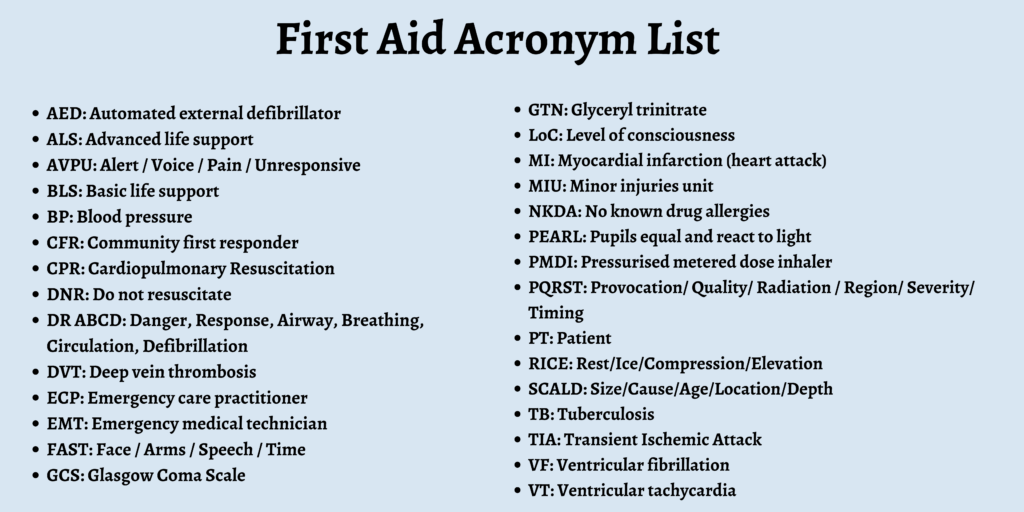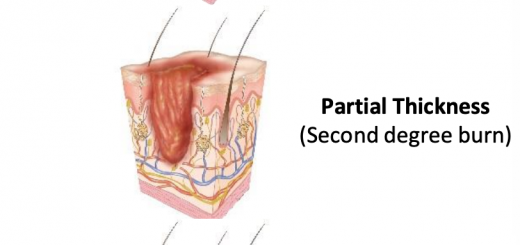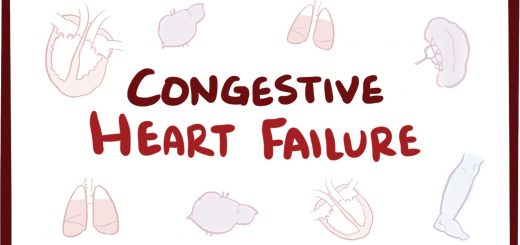First Aid Acronyms
Acronyms are a useful tool to help us remember key actions and information in a first-aid setting. In high-pressure situations, it’s easy to become flustered and forget the skills you’ve learned. Luckily, easy-to-remember acronyms can help to jog your memory so that you can deliver quality first aid in any situation.
If you’ve already begun your first aid training, you’ve probably come across several of these handy memory devices before. The first aid world is packed with acronyms that are designed for jogging our memories about different treatments, and in this post, we’ll explain the meanings of the most common ones.
First Aid Acronym List
When learning first aid, there are a lot of treatments and action steps for a whole host of different injuries and illnesses.
Here’s a list of some common first aid acronyms you may encounter when acting as a first aider. Feel free to leave a comment to suggest a first-aid acronym that we may have missed!
AED: Automated external defibrillator
Commonly known as a defibrillator, this device is used to deliver an electric shock to the heart of a patient suffering from cardiac arrest. The shock aims to reset the heartbeat to a normal rhythm. These life-saving devices can be found commonly in schools, gyms, grocery stores, malls, and other public places.
ALS: Advanced life support
The term ALS is often used interchangeably with ACLS, meaning advanced cardiac life support. ALS or ACLS providers are trained to administer certain treatments that go beyond BLS (basic life support.) They can administer medications, intubate a patient, and use cardiac monitors and other testing devices.
AVPU: Alert / Voice / Pain / Unresponsive
Alert, voice, pain, and unresponsive are terms that describe a patient’s level of consciousness, particularly at the scene of an emergency.
BLS: Basic life support
This is the standard level of care provided by trained first aiders in a life-threatening situation before full medical care arrives.
BP: Blood pressure
Blood pressure is one of the vital signs used in first aid to evaluate and monitor a patient’s health. Other vital signs include heart rate, respiratory rate, and body temperature.
CFR: Community first responder
A community first responder is a trained volunteer who can provide basic life-saving treatment in the event of an emergency until paramedics arrive. They are usually assigned to a particular locality or workplace.
CPR: Cardiopulmonary Resuscitation
CPR is a lifesaving method of keeping blood circulating around the body and delivering oxygen to the organs during cardiac arrest. It involves a combination of chest compressions and rescue breaths.
DNR: Do not resuscitate
A DNR order is a legal document that is issued to some patients who are in end-of-life care. This document informs first aiders and emergency responders to avoid the use of CPR if the patient goes into cardiac arrest.
DR ABCD: Danger, Response, Airway, Breathing, Circulation, Defibrillation
The acronym ‘DR ABCD’ is one of the most important acronyms for a first aider to learn. It is designed to walk responders through a primary survey to assess a casualty and decide on the next steps of treatment.
DVT: Deep vein thrombosis
Deep vein thrombosis is the technical term to describe a blood clot found inside a vein. It usually occurs in the leg and is a life-threatening condition that needs urgent professional medical attention.
ECP: Emergency care practitioner
Emergency Care Practitioners (ECP) are individuals with medical skills and training above that of a standard paramedic or nurse. They usually have a background in paramedicine.
EMT: Emergency medical technician
An emergency medical technician is someone who is trained in BLS (basic life support) and can provide care in an emergency medical situation. Different levels of EMT training can be undertaken depending on a person’s role in the community.
FAST: Face / Arms / Speech / Time
F.A.S.T is a series of tests to determine if someone is having a stroke. Each letter identifies one of the major symptoms of stroke so that medical attention can be sought immediately. The sooner a stroke patient receives medical care, the better their outcome will be.
GCS: Glasgow Coma Scale
The Glasgow Coma Scale is a clinical scale that was originally developed by neurosurgeons in Glasgow, Scotland. It measures the level of consciousness in brain injury victims by assessing eye movements, speech, and physical movement.
GTN: Glyceryl trinitrate
Glyceryl trinitrate is a prescription medication that is commonly used to prevent and treat chest pain, known as angina. It is also used in some medical settings to improve the visibility of a patient’s veins.
LoC: Level of consciousness
Level of consciousness is used to describe how alert, awake, and aware a patient is following an illness, accident, injury, or overdose.
MI: Myocardial infarction (heart attack)
Myocardial infarction is the technical term for a heart attack, a life-threatening condition that occurs when there is a blockage in the blood supply to the heart. Heart attacks with no external symptoms are sometimes referred to as ‘silent MI’s.’
MIU: Minor injuries unit
Minor Injuries Units are walk-in centers designed to treat non-life threatening injuries such as cuts, broken bones, eye injuries, sprains, minor burns, and minor head injuries.
NKDA: No known drug allergies
NKDA is an acronym used by medical professionals on a patient’s records. NKDA refers only to medication allergies and should not be confused with NKA, which means no known allergies of any kind.
PEARL: Pupils equal and react to light
PEARL is a memory device used to assess a patient after a head injury. It helps to establish a patient’s brain function by shining a light into the eye and seeing how the pupils respond. In healthy individuals, the pupils will shrink. If the brain is not functioning correctly, it may stay the same size.
PMDI: Pressurised metered dose inhaler
A pressurized metered dose inhaler is sometimes referred to as a ‘puffer.’ The inhaler delivers a precise dose of aerosolized medication into the lungs. It’s usually self-administered and is commonly used as part of a treatment plan for asthma and various other respiratory diseases.
PQRST: Provocation/ Quality/ Radiation / Region/ Severity/ Timing
PQRST is a memory device used by first aiders and medics to determine a casualty’s level of pain. It also helps in assessing the cause and treatment plan of pain.
PT: Patient
PT simply stands for the patient. It is an acronym often found on medical notes, but it can be used by first-aiders when noting down important information to pass on to emergency services.
RICE: Rest/Ice/Compression/Elevation
The RICE acronym is a memory device that helps first aiders remember the steps to take to treat an injury, relieve pain, and reduce swelling.
SCALD: Size/Cause/Age/Location/Depth
The acronym SCALD is used to assess the severity of a burn and evaluate the need for professional medical attention.
TB: Tuberculosis
Tuberculosis, often referred to as TB, is a serious infectious disease that predominantly affects the lungs. If left untreated, TB can be a life-threatening illness.
TIA: Transient Ischemic Attack
A transient ischemic attack (TIA) is the technical term for a mini-stroke. Unlike a major stroke, symptoms of a TIA usually resolve themselves in under 60 minutes. However, the telltale signs, such as weakness, numbness, slurred speech, and confusion, are the same.
VF: Ventricular fibrillation
Ventricular fibrillation, VF, or sometimes V-fib, is a condition where the heart beats in an abnormal rhythm causing the heart’s ventricles to quiver. If left untreated, it can lead to cardiac arrest and death.
VT: Ventricular tachycardia
Ventricular tachycardia is a faster-than-normal heart rate that stems from the bottom two chambers of the heart.
If left untreated, ventricular tachycardia can develop into ventricular fibrillation, a much more serious condition.
Conclusion
Acronyms are an easy way to remember actions, processes, and other information commonly used in first aid. So, we recommend memorizing the acronyms above to boost your first aid skills and potentially save somebody’s life.







Very comprehensive list of vital things to know! I knew a number of them, but there were others that I’m glad to have learned from reading this.
Many were new to me.